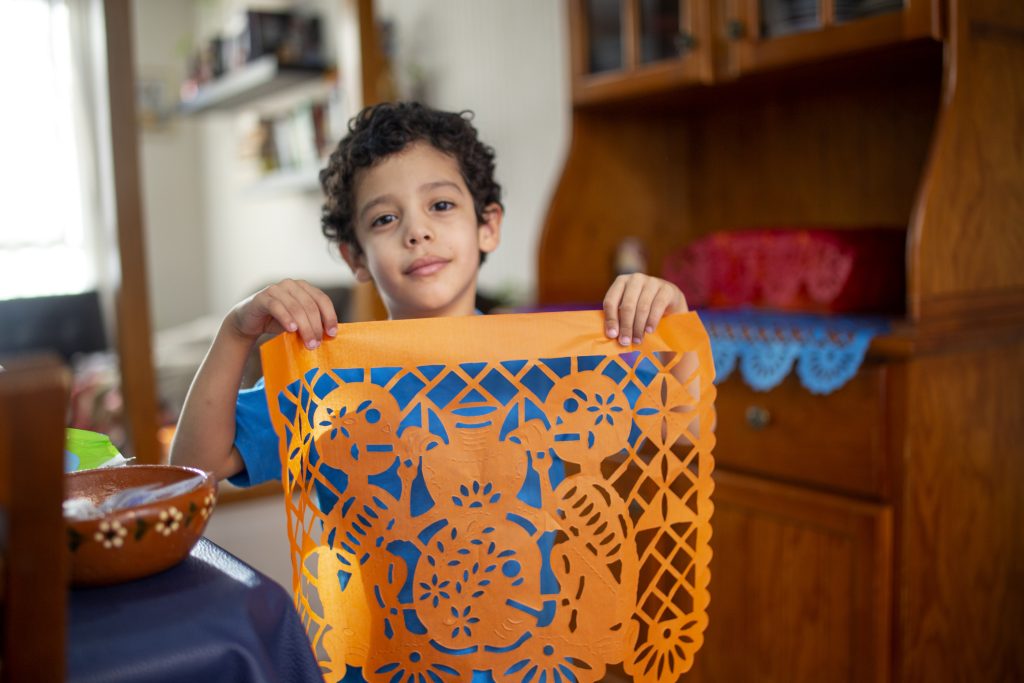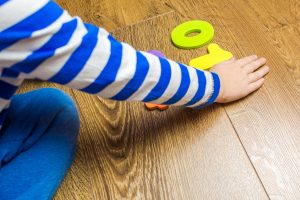Math is often presented in school as disconnected from culture. We may feel that the formal ways in which we learn math in school are the only ways to do math, and that no part of our identities or experiences are related to math. But math has been part of cultural expressions for generations.
By honoring the cultural ways of doing mathematics, math learners gain more windows into and mirrors of the world. [1,2,3] Windows provide opportunities to learn about different experiences, and mirrors allow people to see their own experiences and identities reflected. In this blog, we discuss one such cultural activity that can provide a mirror and window for math learning: The traditional Mexican art of papel picado.
Understand the History of Papel Picado
Papel picado literally means perforated or cut paper. Papel picado is created by cutting geometric shapes from colorful papers to form designs of the sun, skulls, flowers, and other objects. View instructions for making your own papel picado in this PDF.
Although papel picado is displayed around patriotic holidays (such as Mexican Independence Day on September 16), birthdays, and religious celebrations, papel picado is commonly associated with Día de Muertos, or Day of the Dead. The art brings joy and color to families’ ofrendas—altars to honor loved ones who have passed away. The altars typically represent each element of air, fire, water, and earth. Papel picado represents air, from the way it moves in the wind, and candles, water, and foods or flowers can be used to represent fire, water, and earth, respectively.
The practice of papel picado is rooted in the cultural contact between indigenous people of Mexico and the Spanish in the 16th century. Aztec people used obsidian knives to cut figures in paper made from tree bark. They used these carvings for multiple purposes, including religious rituals and decorations. When the Spanish arrived to colonize the Aztec empire, they brought a type of fine paper originating from China that is known as papel China or papel de seda. Spanish people used papel China to wrap porcelain objects during their travels. The patterns and colors of this paper inspired artists of the time to create crafts, such as papel picado.
Papel picado in the way we know it today originated in the state of Puebla, where it is officially considered a cultural heritage. San Salvador Huixcolotla is the municipality considered the cradle of papel picado and other paper folk art. Nowadays, Mexican artists outline a design, place it over several sheets of papel China and use a hammer and chisel to cut the pattern into the paper. There are many family-owned businesses where this art has been taught from generation to generation.
Build Children’s Math Skills With Papel Picado
No matter your cultural heritage, you can enjoy making papel picado with your students or children. All you need is colorful paper and scissors. By folding and cutting the paper, you can create beautiful designs and talk about early math ideas, such as:
Shapes: As you cut, notice the shapes in the papel picado and have children point out all the different shapes that they make! Count the sides of each shape and describe their features. You can ask them questions like, “How do you know this is a triangle?” Drawing attention to the specific features of objects promotes children’s reasoning about shapes. [4,5]
Symmetry: When creating your papel picado, fold the paper in half and cut the paper to create shapes. Notice how your cuts on the papel picado are similar or different on the right and left sides. You can also do the same with the top and bottom of the sheet. See if there are any mirror images. Here you are highlighting symmetry, a foundational concept that allows children to mentally manipulate shapes.
Spatial relations: Notice patterns and designs in relation to each other by describing the location and position of objects. Ask your child: “What do you see in the center? What shape is above that shape? What shape is below?”
Making predictions: After cutting but before opening the folded paper, make a game of predicting what the shapes will look like. Though at first it might be surprising, children will begin to draw connections between the cuts they make and the final shape they unfold.
Making comparisons: Encourage your child to compare how the shapes are the same or different from each other. You can ask, “Which triangle is the biggest? How are this triangle and this square different?” You can also compare one papel picado sheet to another and ask questions like, “Which one has a bigger circle?”
Honor Culture Through Math Activities
Presenting papel picado as a math activity holds up a mirror for people of Mexican heritage. As one of the authors of this blog put it, “Papel picado has been part of my life all my life, and I never thought about papel picado as something that has to do with math.” It can feel affirming and validating to recognize the math present in one’s own cultural activities.
Papel picado is an opportunity to celebrate cultural heritage and learn math at the same time. It is a wonderful example of how math can be creative, holistic, and enjoyable! What other cultural activities can you think of that embed math learning?
Find more ideas for exploring math while making papel picado in this PDF.
[1] Style, E. (1996). Curriculum as window and mirror. Social science record, 33(2), 21-28.
[2] Gutiérrez, R. (2007, October). Context matters: Equity, success, and the future of mathematics education. In Proceedings of the 29th annual meeting of the North American Chapter of the International Group for the Psychology of Mathematics Education (Vol. 18).
[3] Gutiérrez, R. (2018). Introduction: The need to rehumanize mathematics. In Rehumanizing mathematics for Black, Indigenous, and Latinx students. National Council of Teachers of Mathematics.
[4] Clements, D. H. (2003). Geometric and Spatial Thinking in Early Childhood Education. Engaging Young Children in Mathematics: Standards for Early Childhood Mathematics Education, 267.
[5] Fisher, K. R., Hirsh‐Pasek, K., Newcombe, N., & Golinkoff, R. M. (2013). Taking shape: Supporting preschoolers’ acquisition of geometric knowledge through guided play. Child development, 84(6), 1872-1878.



